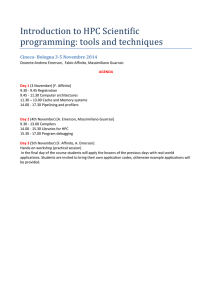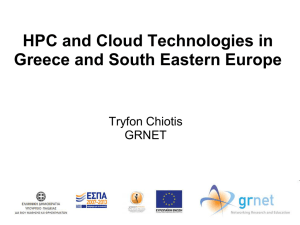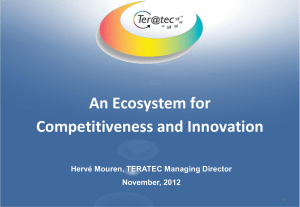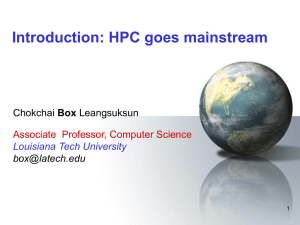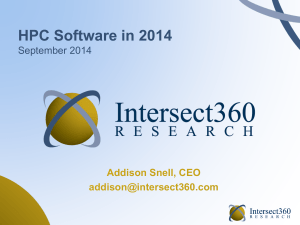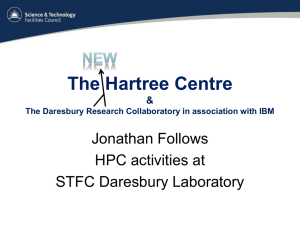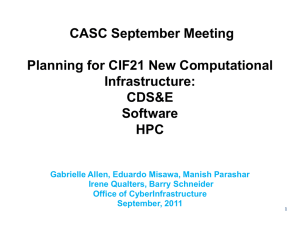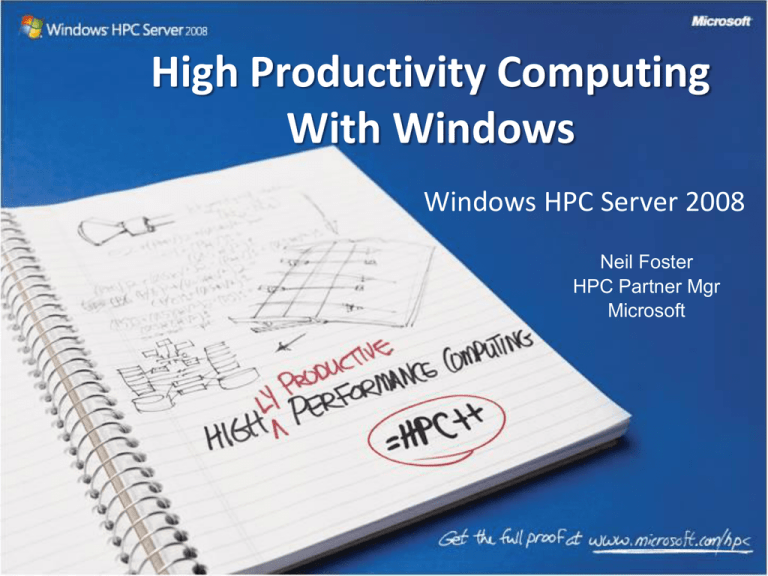
High Productivity Computing
With Windows
Windows HPC Server 2008
Neil Foster
HPC Partner Mgr
Microsoft
Agenda
High Productivity for HPC
Overview Windows HPC Server 2008
Partnerships
Discussion
The purpose if computing is?
‘The purpose of
computing is insight
not numbers.’
Richard Hamming
HPC Drivers
Competitive Advantages
Pressure to improve operational
performance (cost, quality and time
to market)
Quality driven
regulatory compliance
Rapid cycles of product
innovation
The Challenge: High Productivity Computing
High integration pain
•
•
Lack of seamless integration
between workstations, clusters, data
Lack of user workflow integration
across applications and departments
Isolated technology islands
•
•
•
High manual touch
Lack of end-to-end IT process
integration
Cannot leverage existing
investments in broad IT skills and
infrastructure
“Make high-end computing
easier and more productive to
use. Emphasis should be
placed on time to solution, the
major metric of value to highend computing users… A
common software environment
for scientific computation
encompassing desktop to highend systems will enhance
productivity gains by
promoting ease of use and
manageability of systems.”
Application availability
•
•
Limited eco-system of parallel
applications
Lack of developer-friendly tools,
difficult to program
High-End Computing Revitalization Task Force, 2004
(Office of Science and Technology Policy,
Executive Office of the President))
Changing face of HPC
Costs and pain points have moved:
• Manpower more expensive than hardware
• Software is more expensive than hardware
• Every system will be multi-core
• Power, Cooling, facilities much more expensive than
hardware!
• NSF Grants only cover hardware costs
Why Microsoft in HPC?
Current Issues
HPC and IT data centers merging: isolated cluster
management
Developers can’t easily program for parallelism
Users don’t have broad access to the increase in processing
cores and data
How can Microsoft help?
Well positioned to mainstream integration of application
parallelism
Have already begun to enable parallelism broadly to the
developer community
Can expand the value of HPC by integrating productivity and
management tools
Microsoft Investments in HPC
Comprehensive software portfolio: Client, Server,
Management, Development, and Collaboration
Dedicated teams focused on Cluster Computing
Unified Parallel development through the Parallel Computing
Initiative
Partnerships with the Technical Computing Institutes
Microsoft’s Vision for HPC
“Provide the platform, tools and broad ecosystem to reduce the complexity of HPC by
making parallelism more accessible to address future computational needs.”
Reduced Complexity
Mainstream HPC
Developer Ecosystem
Ease deployment for
larger scale clusters
Enable non-technical users to
harness the power of HPC
Increase number of parallel
applications and codes
Simplify management for
clusters of all scale
Address emerging
cross-industry
computation trends
Offer choice of parallel
development tools,
languages and libraries
Integrate with
existing infrastructure
Address needs of traditional
supercomputing
Drive larger universe of
developers and ISVs
Integrated HPC Envirnment
Clients/Job Submission
Development Tools
Administration
Visual Studio: C#,
C++, WCF, OpenMP,
MPI, MPI.NET
Trace Analysis
Batch Applications
SharePoint
Profiling
Windows® HPC Server 2008
Administration Console:
WCF Applications
Excel
Numerical Libraries
MPI Debugging
System, Scheduling, Networking,
Imaging, Diagnostics
CCS Job Console
Windows Workflow
Foundation
Fortran
MPI Tracing
CCS Scripts
Windows Powershell
System Center
Operations Manager
Existing Cluster
Infrastructure
Windows® HPC Server 2008
Job Submission
APIs
WCF Router
UNIX/Linux
System
Job Scheduler w/ Failover
Administration APIs
HPC
Profile
System Center
Data Protection Manager
Compute Nodes
Node Manager
Applications:
WCF, C#, C++, Fortran
New TCP/IP
MPI w/Network Direct
System Center
Configuration Manager
Windows Server
Update Services
Software Protection Services
3rd Party Systems
Management Utilities
Business Intelligence
Storage
Storage
Storage
Key
Partner
Microsoft
HPC Server 2008
Parallel/Clustered
Storage
SQL Structured
Storage
Windows Storage
Server with DFS
SQL Server
Integration
Services
SQL Server
Analysis/
Reporting
What’s New in the HPC Pack 2008
New System Center UI
PowerShell for CLI Management
High Availability for Head Nodes
Windows Deployment Services
Diagnostics/Reporting
Support for Operations Manager
Support for SOA and WCF
Granular resource scheduling
Improved scalability for larger
clusters
New Job scheduling policies
Interoperability via HPC Profile
Systems
Management
Networking
& MPI
NetworkDirect (RDMA) for MPI
Improved Network
Configuration Wizard
Shared Memory MS-MPI for
multi-core
MS-MPI integrated with
Windows Event Tracing
Job
Scheduling
Storage
Improved iSCI SAN Support in
Win2008
Improved Server Message
Block ( SMB v2)
New 3rd party parallel system
file support for Windows
New Memory Cache Vendors
Head Node High Availability
• Eliminates single point of failure with support for high availability
• Requires Windows Server 2008 Enterprise Failover Clustering Services
– Next generation of cluster services
– Major improvement in
configuration validation and
management
• HPC Pack Includes
– Setup integration with Failover
Clustering Services
• Head Node and Failover Node set
up with SQL Failover Cluster
• Job Scheduler services failover
– Management console linked to
Windows Server Failover
Management console
Private
Network
Windows
Failover
Clustered
Head node
Win2008 Enterprise
Clustered SQL
Server
Failover Head node
Win2008 Enterprise
Clustered SQL
Server
Shared
Disk
NetworkDirect
A new RDMA networking interface built for speed and stability
Priorities
– Comparable with hardware-optimized MPI
stacks
•
Socket-Based
App
Focus on MPI-Only Solution for version 2
MS-MPI
– Verbs-based design for close fit with
native, high-perf networking interfaces
– Coordinated w/ Win Networking team’s
long-term plans
•
Implementation
– MS-MPIv2 capable of 4 networking paths:
•
•
•
•
MPI App
Shared Memory
between processors on a motherboard
TCP/IP Stack (“normal” Ethernet)
Winsock Direct (and SDP)
for sockets-based RDMA
New RDMA networking interface
– HPC team partners with networking IHVs
to develop/distribute drivers for this new
interface
Windows Sockets
(Winsock + WSD)
RDMA
Networking
Networking
Networking
WinSock
Direct
Hardware
Hardware
Provider
Networking
Networking
NetworkDirect
Hardware
Hardware
Provider
Networking Hardware
Hardware
Networking
User
Mode Access Layer
TCP/Ethernet
Networking
TCP
Kernel By-Pass
•
IP
NDIS
Networking
Networking
Mini-port
Hardware
Hardware
Driver
Networking Hardware
Hardware
Networking
Hardware Driver
Networking Hardware
Hardware
Networking
Networking
Hardware
(ISV) App
CCP
Component
OS
Component
IHV
Component
User
Mode
Kernel
Mode
Job Scheduling
•
Support for larger clusters
– Create new designs for clusters of size,
including
“heterogeneous” clusters
– Scale deployment and administration
technologies
– Provide interfaces for those accustomed
to *nix
•
Improve interoperability with existing
IT infrastructure
– Interoperability with existing job
schedulers
– High speed file I/O through native support
for parallel and clustered file systems
•
Broader application support
– Simplify the integration of new
applications with the job scheduler
– Addressing needs of in-house and open
source developers
•
Platform Support
– Built for Windows Server 2008
– Cluster nodes with different hardware /
software
Scenario: Broaden Application Support
V1 (focusing on batch jobs)
V2 (focusing on Interactive jobs)
Engineering
Applications
Oil & Gas
Applications
Life Science
Applications
Financial Services
Excel
Structural Analysis
Crash Simulation
Reservoir simulation
Seismic Processing
Structural Analysis
Crash Simulation
Portfolio analysis
Risk analysis
Compliance
Actual
Pricing
Modeling
Job Scheduler
App.exe
App.exe
Your applications
here
WCF Service Router
+
Resource allocation
Process Launching
Resource usage tracking
Integrated MPI execution
Integrated Security
App.exe
Interactive
Cluster
Applications
App.exe
WS Virtual Endpoint Reference
Request load balancing
Integrated Service activation
Service life time management
Integrated WCF Tracing
Service
(DLL)
Service
(DLL)
Service
(DLL)
Service
(DLL)
Interoperability & Open Grid Forum
What is it?
What is its value?
What’s the Status?
•A draft OGSA (Open Grid Services
Architectures) interoperability standard
for batch job scheduler task submission
and management
•Based on web services standards (HTTP,
XML, SOAP)
•Enables integration of HPC applications
executing on different platforms and
schedulers via web services standards
•Passed the public comment period
•Working on new extensions
LSF / PBS / SGE / Condor
Linux, AIX, Solaris
HPUX, Windows
Windows Cluster
Windows Center
Window Center
Spring 2008, NCSA, #23
9472 cores, 68.5 TF, 77.7%
Spring 2008, Umea, #40
5376 cores, 46 TF, 85.5%
Spring 2008, Aachen, #100
2096 cores, 18.8 TF, 76.5%
Fall 2007, Microsoft, #116
2048 cores, 11.8 TF, 77.1%
30% efficiency
improvement
Windows HPC Server 2008
Spring 2007, Microsoft, #106
2048 cores, 9 TF, 58.8%
Windows Compute Cluster 2003
Spring 2006, NCSA, #130
896 cores, 4.1 TF
Winter 2005, Microsoft
4 procs, 9.46 GFlops
Customers
“Ferrari is always looking for the most advanced technological solutions and, of course, the
same applies for software and engineering. To achieve industry leading power-to-weight
ratios, reduction in gear change times, and revolutionary aerodynamics, we can rely on
Windows HPC Server 2008. It provides a fast, familiar, high performance
computing platform for our users, engineers and administrators.”
-- Antonio Calabrese, Responsabile Sistemi Informativi (Head of Information Systems), Ferrari
“The Umeå cluster with Windows HPC Server 2008 performed well enough to
become the fastest academic system in Sweden. We are very happy with that result.”
-- Bo Kågström, Professor and Director,
High Performance Computing Center North Umeå University
“Financial analysts in Europe mainly use Windows systems. As such, the deployment of
a Windows HPC Server 2008 cluster renders our HPC services extremely
attractive to a large potential user base.”
-- Dr. M. Rosati, Manager of the Computational Materials Science and Finance Group, CASPUR
“We are really impressed with many of the new features of Windows HPC
Server 2008. Microsoft is a pretty young player in the HPC market, but this is already
a very solid product.”
-- Christian Terboven, Project Lead for HPC on Windows, Center for Computing and
Communication, RWTH Aachen University
Parallel Programming
•
Available Now
–
–
•
Emerging Technologies – Parallel Framework
–
–
•
Development and Parallel debugging in Visual Studio
3rd party Compilers, Debuggers, Runtimes etc.. available
LINQ/PLINQ – natural OO language for SQL queries in .NET
C# Futures – way to explicitly make loops parallel
For the future: Parallel Computing Initiative (PCI)
–
–
Triple investment with a new engineering team
Focused on common tools for developing multi-core codes from desktops to clusters
Compilers
• Visual Studio
• Intel C++
• Gcc
• PGI Fortran
• Intel Fortran
• Absoft Fortran
• Fujitsu
Profilers and Tracers
• PerfMon
• ETW (for MS-MPI)
• VSPerf /VSCover
• CLRProfiler
• Vampir (Being ported to
Windows)
• Intel
Collector/Analyzer(Runs
on CCS w Intel MPI)
• Vtune & CodeAnalyst
• Marmot (Being ported to
Windows)
• MPI Lint++
Debuggers
• Visual Studio
• WinDbg
• DDT
Runtimes and Libraries
• MPI
• OpenMP
• C# Futures
• MPI.C++ and MPI.Net
• PLINQ
Microsoft approach to HPC
Best of breed software and Partners:
• Partner with every hardware vendor
• Partner with every software vendor (even Novell!)
• One integrated platform (Windows)
• Stick to our competencies: OS, management,
development, tools, user interface, etc.
Cross Microsoft Effort
“Here and Now”
Technologies
Emerging Technologies
Research
Product Teams
Windows HPC Server
SQL
Office
Visual Studio
Microsoft Research
eScience
External Research &
Programs
External Research Office
Industry Focused Solutions
Academia Aerospace Automotive
Financial
Services
Geo
Life
Services Government Sciences
Company Introduction
Cluster Resources (CRI) are based in Utah, USA and Cambridge, UK
CRI’s core product is Moab
Moab’s pedigree goes back more than 10 years to the Maui scheduler
CRI develop, maintain and support 2 open source products:
TORQUE compute resource manager
GOLD resource allocation and accounting suite
Best efforts support for SLURM
Moab is widely installed on the TOP 500 systems, and is the scheduler for the
worlds first petaflop system at LANL
ACADEMIC INSTALLATIONS OF MOAB
•
•
•
•
•
•
•
•
Cambridge
Cardiff
Birmingham
Bristol
UCL
UCD
St. Andrews
ICHEC
Adaptive/Dynamic: Windows/Linux Cluster
Definition: Moab is able to dynamically
monitor & then adjust the operating
system or other environmental factors
to meet the needs of current and
upcoming workload. Moab can
manipulate, grow and shrink the
allocated resources in order to meet
QoS targets.
Examples of Dynamic Adaptations:
• Operating Systems
• Services
• Network / Bandwidth
• Application Resources
• Storage Space
• Etc.
Moab
Linux
RM
Linux
Workload
Windows Workload
Windows
RM
Upcoming Workload
Linux
Windows
Note: RM is responsible for
monitoring and job execution.
Note: Moab's Dynamic
Adaptation capability is
based on its abstracted
workload concept and its
ability to import data from
external resource managers.
Allinea Software
• Offers next generation tools for parallel application
development
– Traditionally for clusters, SMPs and MPPs
– Focus on usability and scalability
– Cross platform with Windows and Linux / UNIX
• Addressing future requirements
– Growth in processors / cores ...
– Growth in parallel and distributed programming ...
• Application of this technology
– Experience from HPC to the desktop
– Experience of embedded applications
High Profile Clients (extract)
• National research
centres
– AWE, BSC, CASPUR, CEA,
CINECA, HLRS, ICHEC,
IDRIS, LLNL, ONERA,
PROUDMAN, RAL, ….
• Universities
– Bristol, Dresden, Edinburgh,
HLRS, IPGP, Jülich,
Karlsruhe, Leicester, LRZ,
North West Grid, Oxford,
PenState, Nottingham,
Sharcnet, TACC, Tokyo,
UFA, Vanderbilt, etc.
• Aerospace research
– CIRA, EADS CCR, DLR,
MBDA, etc.
• Commercial research
– Airbus, AVL, CGGVeritas,
Fujitsu (Japan & UK), IFP,
MTEM, OHM, Total, etc.
DDTLite Plugin for Visual Studio®
• New product from Allinea
– Simplifies Parallel development on Microsoft®
platforms
– Bringing popular features from DDT to Visual
Studio®
– Makes easy path from Linux/Unix to
Microsoft® world
– Available Q4 2007
Resources
• Microsoft HPC Web site – download Beta 1 Today!
– http://www.microsoft.com/hpc
• Windows HPC Community site
– http://www.windowshpc.net
• Windows Server x64 information
– http://www.microsoft.com/x64/
• Windows Server System information
– http://www.microsoft.com/windowsserver
• Get the Facts Web site
– http://www.microsoft.com/getthefacts
© 2008 Microsoft Corporation. All rights reserved.
This presentation is for informational purposes only. Microsoft makes no warranties, express or implied, in this summary.

